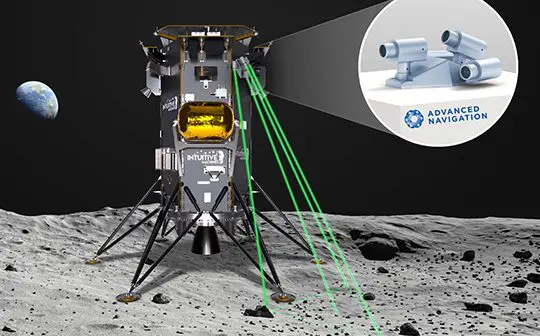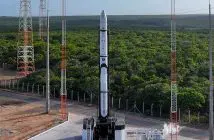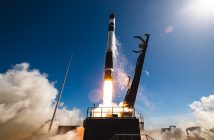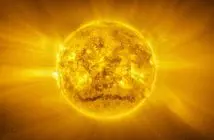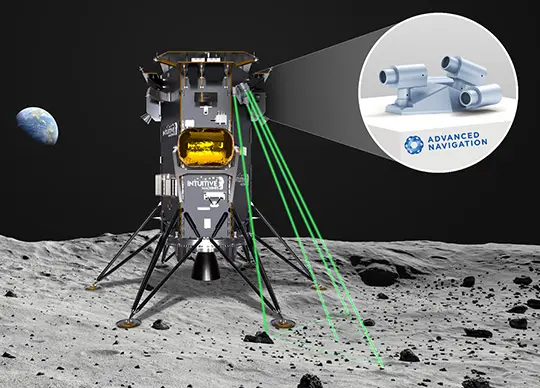
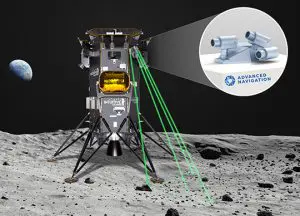
Image: Concept representation of Intuitive Machines Nova-C Lander on the Moon with Advanced Navigation.
Advanced Navigation has announced its ambitions to be the first Australian company to reach the Moon through its development of two unique navigation systems.
“The team is absolutely thrilled to see years of research in development progress into successful technology. We look forward to being the first Australian company to reach the Moon in 2024, this will be a huge milestone for us,” said Xavier Orr, CEO, and co-founder at Advanced Navigation.
“Inertial and robust reference-based navigation is a critical capability in space missions, where terrestrial navigation satellite systems, such as GPS are non-existent. Our lightweight technology is estimated to deliver $85 million in value for lunar missions, helping to deliver heavier payloads to further advance research, exploration, and commercial developments on the Moon.”
MINIATURISATION OF TECHNOLOGY
Developed from over twenty-five years of research with prominent academic institutions, the two unique patented technologies deliver breakthroughs in performance, reliability, size, weight and power consumption.
Lighter, more compact flight systems that integrate into the guidance navigation and control (GNC) system are integral in reducing the overall weight of the spacecraft.
This helps provide more space for commercial “payloads” such as satellites, research, and test equipment, or personnel. The heavier the payload the more expensive and complex it is to deliver.
There are major cost savings to be gained by adopting technology that provides the spacecraft with more payload space. Advanced Navigation delivers just this with its latest technology.
Both systems will enable positioning and accuracy that exceeds the best-demonstrated products in the world today while weighing far less.
The Boreas X90 is a strategic grade inertial navigation system (INS) that enables positioning and navigation capable of maintaining extreme precision without using relatively fixed references, such as stars, or requiring base station control telemetry. This is critical for long-endurance space missions involving complex orbits and trajectories.
The light detection altimetry and velocimetry (LiDAV) system uses lasers to measure a significant number of parameters detailing a vehicle’s environment. Most importantly it can indicate the vehicle’s velocity and position relative to the lunar surface in three dimensions with extreme accuracy and precision.
When visual references are unavailable and cameras fail due to lack of light, dust and other obscurities, LiDAV will provide primary navigation input. This technology is critical to perform complex autonomous landing procedures and confidently explore the lunar surface.
Spacecraft autonomy requires extraordinary situational awareness. Although the systems can be used as independent components of the spacecraft’s GNC autonomous stack, they can also be fused.
INTUITIVE MACHINES
Intuitive Machines provide commercial transportation, communication, and operations services to the lunar surface. The company has three lunar lander missions that will deliver at least two lunar communication relay satellites by 2025. Their customers include NASA’s Commercial Lunar Payload Services initiative and Tipping Point technology opportunity.
Advanced Navigation and Intuitive Machines are following the leadership of the U.S. and Australian governments in the Artemis Accords to undertake safe and peaceful space exploration while gaining a deeper understanding of Earth’s own satellite, the Moon.
Dr. Tim Crain, Chief Technology Officer at Intuitive Machines explained “Lightweight precision navigation sensors are essential for delivering science and technology payloads to the lunar surface. These technologies also support data collection for science and resource prospecting once on the Moon.”
“Demonstrating this technology in the near term is essential. By 2026, our next phase of lunar lander, Nova-D, will begin delivering 500-1,000 kg of payload to the lunar surface, and we require access to reliable, redundant, and dissimilar sensors for landing,” said Crain.
“It’s imperative that our large lunar payload customers are confident that our systems will deliver the cargo safely and reliably. If we can demonstrate Advanced Navigation’s technology on our current Nova-C landers, we can significantly improve the robustness of landing with Nova-D.”
“Given the light weight and capabilities of the Advanced Navigation sensor systems, they are well suited for our Micro-Nova, a mini-extreme mobility lunar vehicle also known as a “hopper”. Mass on the hopper is at a premium, but we require sensors that can help us fly to permanently shadowed craters and through lava tubes. We look forward to discovering more of the lunar surface with Advanced Navigation.”
THE FUTURE OF THE NEXT FRONTIER IN AUSTRALIA
The development of the Boreas X90 was supported by the Australian Space Agency through its Moon to Mars Initiative: Supply Chain Capability Improvement Grant
Enrico Palermo, Head of the Australian Space Agency said “Our Moon to Mars initiative provides Australian companies with the opportunity to showcase their knowledge and capabilities in projects that can support NASA in its inspirational endeavours. Advanced Navigation’s partnership with Intuitive Machines shows this initiative is accelerating Australian companies into international space supply chains.”
“It’s great to see Advanced Navigation continue to disrupt and challenge the status quo. Their latest technology will not only increase Australia’s space capability, but create exciting long-term export opportunities, bolster careers in the STEM sector and inspire the Australian public,” said Palermo.
“This is just one example of how Australia is collaborating with NASA on its Artemis program and is building on over half a century of collaboration in space. The Agency has also reached an agreement with NASA for an Aussie designed, built and operated rover to be included in a future mission.”
NOT EXCLUSIVE TO SPACE TERRAINS
Space is but one frontier, this technology will have several applications on earth. The technology is well suited to aid aircraft during take-off and landing, particularly in hazardous conditions. It can also measure weather patterns far more accurately which will significantly improve weather detection and forecasting.
In the future, this technology will guide flying taxis helping to deliver passengers to their destination safely. It will also navigate autonomous vehicles reliably under all conditions and build geophysical models from gravitational surveys.

